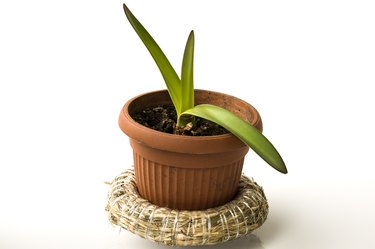
Amaryllis (Hippeastrum spp.) is a bulb plant that produces tall stems and bright blossoms in summer. Shady conditions, overfertilization, and overwatering are among the factors that can cause an amaryllis to produce leaves but no flowers.
Amaryllis is hardy in U.S. Department of Agriculture plant hardiness zones 8b through 11a. In colder zones, it's often grown as a houseplant.
Video of the Day
Video of the Day
Too Little Light Reduces Blooms
Indoors and outside, an amaryllis needs bright conditions in order to blossom. Place an amaryllis houseplant near a window that receives morning sunlight. The area should remain bright in the afternoon as well, but it needn't receive direct light beyond the morning.
Grow an outdoor amaryllis in bright shade. They will also bloom in sites that receive dappled sunlight, such as under a tree. They won't bloom in shade.
Too Many Nutrients and Too Much Water Reduce Blooms
Three recipes for lush, leafy amaryllis growth but no flowers include rich soil, excess fertilizer, and/or excess water.
Think moderation in all things amaryllis. It's best to plant an outdoor amaryllis in a bed with average, freely draining soil and to grow an indoor plant in general-purpose, well-drained potting soil in a container with drainage holes.
An amaryllis in a container will not require any fertilizer until after the flower bulb appears. Fertilize the garden bed before planting an outdoor amaryllis. Evenly sprinkle a ready-to-use 6-6-6, slow-release fertilizer at a rate of about 3 ounces per 10 square feet. Mix the fertilizer into the soil to a depth of 6 inches. Don't fertilize the amaryllis again before flowering.
An established outdoor amaryllis tolerates drought. Water an outdoor plant when the soil is dry to a depth of 2 to 3 inches. Apply water until the soil is moist to the depth of the bulb roots. Overwatering an amaryllis houseplant can cause bulb rot. Water an indoor plant when you first plant it in the container and then don't water it again until you can see the roots through the drainage holes. After the roots appear, water the plant when the potting soil is dry to a depth of 1 inch. Pour water into the container until it flows through the drainage holes.
Early Lifting Stops Blooms
Amaryllis bulbs store up energy this year for the next year's flowering. Lifting an amaryllis bulb from its outdoor site or from an indoor pot too soon prevents the plant from storing energy. An in-ground amaryllis should not be lifted for winter storage until fall, when the foliage naturally dies down. Bring an amaryllis in an outdoor container inside before the first frost in fall.
An amaryllis that doesn't experience at least two months of dormancy won't flower again. Dig up an outdoor amaryllis and place it in a dry, shady place for eight weeks before replanting it. Place an indoor plant in its container in a dry place at temperatures between 40 and 45 degrees Fahrenheit.